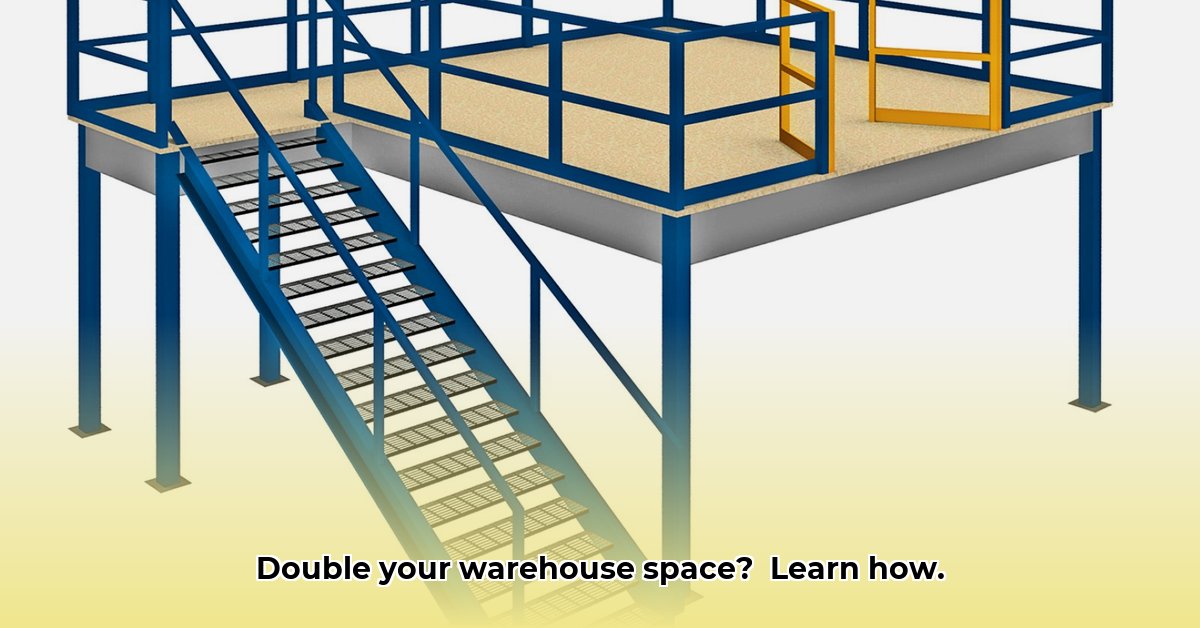Running out of warehouse space and feeling the pinch? A steel mezzanine floor could be your solution. This guide covers selecting the right system, from load capacity and code compliance to installation ease and long-term costs. We’ll analyze brands like FCP, Wildeck, and KABTech, discuss potential problems, and assess the investment’s value. Transform your warehouse into a profit-boosting powerhouse! For a more detailed introduction to mezzanine floors, check out this helpful resource.
Understanding Steel Mezzanine Floor Systems
A mezzanine—an intermediate floor—is a smart space-saving solution for warehouses. However, navigating the selection process of a steel mezzanine system can be complex. This guide simplifies the process, aiding informed decisions that improve warehouse efficiency and profitability. Let’s explore key elements in optimizing warehouse space.
Key Factors in Choosing an Industrial Steel Mezzanine
Before comparing companies, consider essential factors affecting budget, project timeline, and long-term warehouse operations. Carefully consider these choices for optimal warehouse performance.
-
Load Capacity: Crucial for worker and inventory safety. Ensure the system exceeds planned weight and dynamic loads from equipment like forklifts. Insufficient capacity can lead to structural failure. Consider the load capacity meticulously, accounting for future expansion.
-
Code Compliance: Varies significantly by location and intended use (storage, office, manufacturing). Ensure the system fully meets local building codes, fire safety regulations, and OSHA requirements to avoid costly rework and legal liabilities. Verify code compliance for safety and legality.
-
Material Handling Integration: Proactively consider lifts, conveyors, or other material handling equipment for efficient goods flow to and from the mezzanine. Integrate material handling for optimized efficiency.
-
Customization: Flexibility is vital for accommodating current and future business needs. Understand the customization options regarding size, layout, flooring, and access points. Can you easily reconfigure it for evolving warehouse layouts?
-
Installation Time: Fast installations minimize downtime and allow for quicker warehouse operations resumption. Prefabricated systems offer potential speed advantages.
-
Cost Analysis: Think beyond initial purchase price, including installation, permits, insurance, long-term maintenance, potential downtime costs, and energy efficiency. Cheaper options upfront might prove more expensive in the long run. Plan for the long term with a comprehensive cost-benefit analysis.
-
Maintenance Considerations: Assess lifespan, maintenance requirements, and potential repair costs for accurate overall cost assessment. Check on what maintenance is needed to ensure longevity and safety.
Top Steel Mezzanine Companies: FCP, Wildeck, and KABTech Comparison
Consider three major players: FCP, Wildeck, and KABTech, each with their own strengths in design, materials, and features. This comparison is akin to choosing a car model, each offering distinct benefits and drawbacks.
| Feature | FCP | Wildeck | KABTech |
|---|---|---|---|
| Design Philosophy | Innovative, moment-resistant, rigid frame | Focuses on integrated systems | Custom solutions tailored to specific needs |
| Material Handling | Typically separate; integrates with cranes/lifts | Often integrates with VRCs (Vertical Reciprocating Conveyors) | Offers vertical product material lifts |
| Customization Level | Moderately customizable | Moderately customizable | Highly customizable |
| Code Compliance | Strong emphasis on pre-approved designs | Adheres to stringent industry standards | Designs to meet or exceed the latest building codes, including seismic requirements |
| Installation Speed | Generally quick | Varies depending on complexity | Offers turn-key packages for design and installation |
| Key Strengths | Simplified permitting, strong safety record | Streamlined material handling and efficiency | Flexibility in design and comprehensive project management |
| Potential Drawbacks | Less flexibility in complex customizations | Installation time can vary | Requires detailed upfront planning |
Risk Factors: Potential Issues and Mitigation
Potential issues include material defects, installation errors, design flaws, code violations, and inadequate load capacity. Assess the likelihood and severity of each problem with each system to proactively mitigate risks and avoid unexpected disruptions. Thorough planning and due diligence are crucial.
Code Compliance and Legal Considerations
Ensure strict adherence to all applicable federal, state, and local building codes, fire safety regulations, and OSHA standards to obtain necessary permits and avoid legal repercussions. Confirm regulations for long term operational safety and compliance.
Evaluating Investment Value: Return on Investment (ROI)
Steel mezzanines are a capital investment with significant potential returns. Thoroughly weigh initial purchase, installation, permit, insurance, maintenance, energy efficiency, and potential downtime costs against increased storage capacity, improved operational efficiency, and reduced real estate needs. Consider ROI for informed decision-making.
Making the Right Choice for Your Steel Mezzanine
Choosing a steel mezzanine system requires careful consideration of warehouse needs, operational priorities, available budget, and long-term growth plans. Plan carefully, research thoroughly, and consult experienced structural engineers and mezzanine specialists for personalized guidance. Ongoing research on innovative designs might highlight systems not covered here. Consider consulting with industry experts for tailored recommendations.
Comparing Industrial Steel Mezzanine System Load Capacities and Pricing Per Square Foot
Key Takeaways:
- Mezzanine weight capacity is paramount, dictated by intended use, materials, and structural design. Actual capacity varies considerably (typical ranges exist: 125-500 psf or more).
- Maximizing capacity entails a cost-effectiveness analysis, balancing initial investment with long-term operational flexibility. Higher initial investment often yields long-term savings.
- Steel and concrete offer superior strength compared to wood. Even weight distribution is vital to minimize stress on the structure. Regular inspections are essential for ongoing safety.
- Design variations dramatically impact capacity. Freestanding systems offer greater adaptability but higher costs than rack-supported ones. Moment connections enhance stability, particularly in seismic zones. Soil conditions and slab thickness necessitate site-specific engineering. Point loads require careful design adjustments.
Load Capacity and Pricing: A Detailed Look
Frankly, comparing industrial steel mezzanine system load capacities and pricing per square foot extends beyond simple numbers. It’s fundamentally about safety, operational efficiency, and maximizing long-term value. A poorly designed or under-specified mezzanine system represents a costly and potentially dangerous mistake. How much weight can your mezzanine floor system reliably support? The answer dictates your warehouse layout, storage strategies, and equipment choices. Are you primarily considering lighter-duty carton storage or heavy pallet loads with forklift traffic? This crucial factor dictates the structural requirements and load-bearing capacity needed.
Factors Affecting Cost and Capacity
Several interrelated factors influence both the load capacity and the price per square foot:
- Material Selection: Higher-strength, heavier-gauge steel supports greater weight but increases material costs.
- Structural Design: Column spacing, bracing patterns, beam sizes, and connection types (moment vs. simple) significantly affect load-bearing capability and overall cost.
- Live vs. Dead Loads: Accurate calculation of both dead loads (the weight of the structure itself) and live loads (storage, equipment, personnel) is essential. Underestimating these loads leads to structural failure.
- Code Compliance: Building codes mandate minimum load requirements based on intended use, directly impacting material and design specifications, thereby increasing cost. Ignoring compliance carries unacceptable risks.
Vendor Considerations: Overview
While detailed comparisons require specific project parameters, we provide general differences when comparing industrial steel mezzanine system load capacities and pricing per square foot:
| Vendor | Typical Load Capacity (psf) | Pricing per sq ft (Estimate) | Customization Options | Common Applications |
|---|---|---|---|---|
| FCP | 250 – 500+ | $$$$ | High | Heavy-duty storage, manufacturing, equipment platforms |
| Wildeck | 200 – 400 | $$$ | Medium | General storage, light manufacturing, in-plant offices |
| KABTech | 150 – 500+ | $$-$$$ | High | Wide range: storage, retail, processing plants |
Note: These are broad estimates. Actual capacity and pricing depend heavily on project specifics (location, size, load requirements, complexity, code requirements). Consult qualified structural engineers for precise design and cost estimates.
Reducing Risk
Ignoring potential hazards can be disastrous. Thorough risk assessment and mitigation planning are crucial. Here’s a simplified risk assessment:
| Risk | Probability (High/Medium/Low) | Impact (High/Medium/Low) | Mitigation Strategy |
|---|---|---|---|
| Material Failure | Low | High | Employ high-quality, certified materials; conduct regular, documented inspections |
| Improper Installation | Medium | High | Utilize certified and experienced installers; strictly adhere to manufacturer guidelines |
| Non-Compliance | Low | High | Ensure thorough understanding and strict adherence to all relevant building codes |
Return on Investment (ROI) Considerations
Investing in a correctly designed and installed mezzanine system delivers a substantial long-term ROI through increased storage capacity, improved operational efficiency, and optimized workflow. The right choice pays dividends. A poorly planned or under-specified system results in ongoing costs related to safety concerns, operational inefficiencies, and potential downtime.
Steel Mezzanine Systems for Cold Storage Warehouses Vertical Space Optimization
- Glass Tile Shower Ideas to Create a Stunning Bathroom Space - December 7, 2025
- Glass Wall Tile Ideas for Kitchens and Bathrooms - December 6, 2025
- Glass Tile Bathroom: Create a Beautiful, Easy-Clean Space - December 5, 2025










